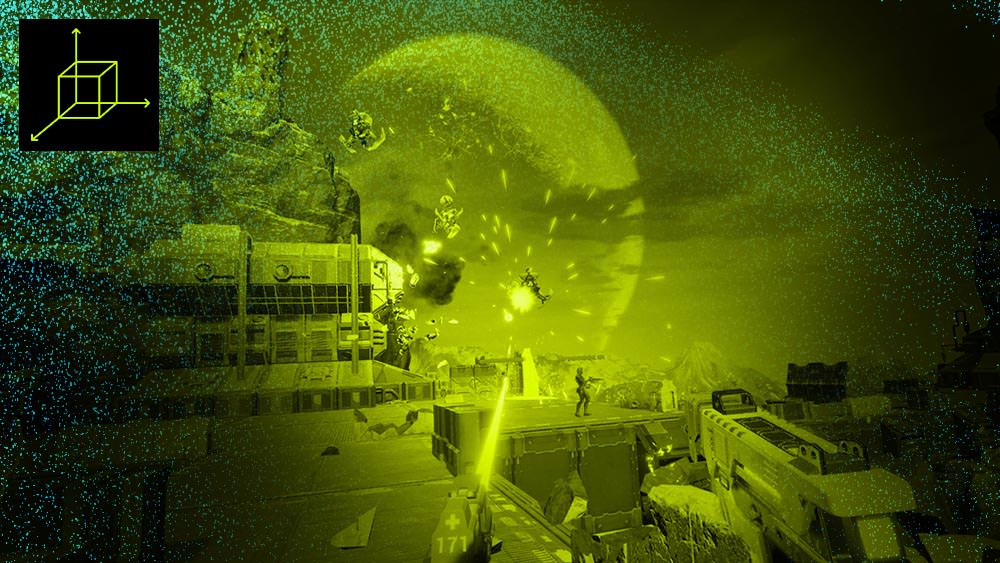
First-person shooters (FPS), being massive hits on PC and consoles, might seem like a natural fit for VR, but they have proved to be a tough genre for developers to cover. While games such as Robo Recall, Doom VFR, Raw Data and others have significantly moved the genre forward in the VR space, they’re still a step or two away from a truly authentic shooter experience, and that’s because of the way players move their characters around. Very few games use straight movement in VR for fear that it will make users sick, so they usually choose to use a teleporting option instead.
Vancouver-based developer Archiact believes it has the answer to the problem. It has been making games for VR for about four years, with platform experience that range from Google Cardboard to Samsung Gear VR and PlayStation VR, and now it is preparing to move the FPS genre forward with Tuesday’s announcement of Evasion, its first game for the Oculus Rift and HTC Vive.
“Evasion is an intense VR ‘bullet hell’ shooter that focuses on multiplayer,” Archiact senior producer Jennifer Dowding told AListDaily. A bullet hell game is one where players must find ways to survive a hailstorm of gunfire by evading (thus the title) or deflecting bullets while destroying enemies and completing objectives.
Expected to launch in 2018, Evasion also pushes the envelope of VR gameplay by featuring four-player cooperative class-based multiplayer using full-body avatars powered by IKinema motion capture technology, giving players a truer sense of self while in VR. Furthermore, the game lets players drop in and out of games at any time, and missions have randomized elements for high replayability.
According to Dowding, who was joined by Archiact lead game designer Ian Rooke and the studio’s brand manager Chris Ansell, the idea for Evasion came as Archiact was designing a simple two-player VR arcade shooter for the Asian market. After discovering how much fun the bullet hell mechanic was, the company decided to make something ambitious out of it.
“We immediately knew that we wanted to do something much bigger,” Dowding said. “It became a passion for the team to create something that was what the audience was looking for and what we were looking for as gamers.”
Showcasing VR
Intel selected Evasion as a VR showcase partner, where it’s in good company alongside zombie shooter Arizona Sunshine and Ubisoft’s Star Trek: Bridge Crew. The Intel VR showcase is both a technological and marketing partnership that helps developers grow the VR industry.
“On the marketing side, the goal is to get the game into as many players’ hands as possible,” said Dowding, detailing the partnership. “We’re working with Intel to showcase the game at events, give away codes and do retail activations to get more players into the game. Since this is a co-op shooter, we don’t just want you to play, we want you to play with your friends. We’re working with Intel to see how we can make that happen.”

Before the announcement, Evasion was limited to private showings at events such as VRDC. Now that it’s been officially unveiled, the game will be shown to the public for the first time at the Intel Extreme Masters in November. Attendees will not only have a chance to play, but they’ll watch others move as they play, which will be key to bringing more attention to the game.
“It’s a really exciting game to watch people play,” Dowding explained. “Because there’s a whole-body avatar, you can crouch down behind cover and lean around corners. Those things are very advantageous in the game. The best players will be moving around a lot during the game, so it’s as much fun to watch as it is to play.”
“A lot of VR games have simplistic representations of people’s bodies, and that throws you out of the immersion,” Rooke added. “One of the benefits of having a full body in VR is that when someone is really good, you can tell. It’s really obvious that that’s an amazing player. So, we want to embrace the concept of spectating and finding really good players to champion the game.”
Authentic movement will also help further grow the VR market by giving its players something they demand. In fact, it was the room-scale full-body movement detection that drew Archiact to develop Evasion for the Oculus Rift and HTC Vive.
“A lot of VR gamers are over the hump of teleportation and they want more out of VR shooters,” said Ansell.
“VR gamers want an authentic VR first-person shooter experience, and that’s what we’re looking to provide, but we’re also offering a lot of setting so that players feel comfortable in the game,” said Dowding. “As we’ve been demoing, we found that there is no one path for each person. Every person has unique settings and we want to support as many as we can. We even have a jogging mode, where you have to jog up and down to move, and that helps overcome sickness by providing deeper simulation.”
In addition to movement, Dowding explained that Evasion’s cooperative gameplay is also a standout feature.
“We really love this idea of playing with your friends in squads,” she said, echoing the sentiment that VR needs to become a more social experience. “We found that one of the things that makes VR compelling is having a friend jump in with you to play together and fight alongside each other. That was one of the reasons why we leaned into co-op.”
The trade-off to cooperative play compared to competitive gameplay is that it can never be technically regarded as an esport. The three said that a competitive game may be developed in the future, but right now, the focus is on cooperative play. Rooke added that cooperative play also makes the game more flexible for single-player sessions, when players can’t find anyone to join them.
On Location
Given Evasion‘s arcade roots, Archiact is designing the game to better support location-based experiences. A special survival mode, which focuses more on arcade scoring, is in the works. Furthermore, Rooke said that the missions are scalable so that they can be anywhere from 10 to 45 minutes long.
“[Location-based experiences] are the first point of contact that a lot of users will get for VR,” said Dowding. “We want to make something that they can try out for the first time and have a good time before going home and considering buying it home for a bigger experience.
“I hope that we’ll see more VR in arcades and other location-based experiences like theme parks because they are great first points of contact. In Asia, it may be their only point of contact because they have small places. So, being able to use devices in smaller spaces and more access to them will definitely help the technology out.”
Growing Mass Appeal
Dowding also believes that developing for the existing VR market is critical. Giving the VR audience what it wants gets them excited and talking about it, which benefits both marketing and development.

“The VR audience is very passionate, and this is the content they’re looking for,” she said. “The bigger game companies aren’t making the content they’re looking for right now. If we were competing with something like Star Wars: Battlefront with a VR mode, we would never be able to compete with those kinds of AAA marketing budgets. But the VR audience is a little starved for content right now.”
“We kind of see it as our duty to help the industry move forward,” said Rooke. “We understand that it’s expensive and a lot of people don’t have a reason to pick up a VR headset, so we want to help by adding good content to the VR library and give people more reason to jump into VR.”
Rooke also said that for the VR industry to grow, the hardware needs to get cheaper untethered. Games also have to get past the “locomotion hump.”
“A lot of people are afraid of getting sick in VR, so they’re afraid to try it,” he explained. “We think that getting more content out there that has good locomotion will make people realize that it can be done, and that will be a huge step [towards growth].”
Archiact has been working with Oculus, HTC, Nvidia and Epic Games’ Unreal Engine team to make sure they’re exploiting the best uses for their technology. Ansell said that working closely with partners is the best chance VR teams have at success.
The company also hosts CVR, an annual VR consumer expo that began two years ago in Vancouver. It features prominent members of the VR community—from Microsoft to NASA—further demonstrating the studio’s commitment to growing the VR space.
“If you’re excited about the vision for your game, whether it’s VR or not, then you generally jump out of bed each morning to make it because you want to play it,” said Ansell. “I think that’s where you have to always start. Despite challenges in the VR market cycle, putting our heads down and focusing on what we want to play and what we think gamers want has consistently led to good things. Hopefully, that will continue, and we will work with partners who share the vision.”

